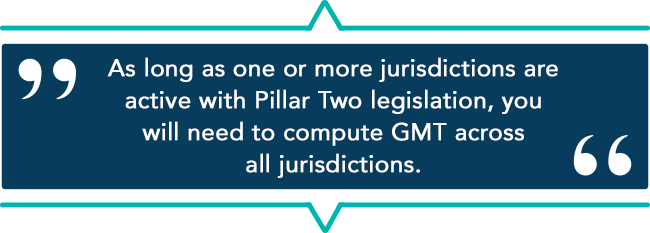As we help clients navigate the challenges of Pillar Two, we’re hearing some common misconceptions. We’d like to share a few of them here and set the record straight.
Misconception 1: The US Congress hasn’t come to an agreement on Pillar Two. Until they do, US-based multinational enterprises should focus solely on the CAMT.
![]() Pillar Two adoption by the US is irrelevant to the compliance burden Pillar Two model rules pose to tax teams. Non-adoption simply means the US won’t collect any Top-up tax, but another jurisdiction may. So, if you’re headquartered in the US, and you operate in a jurisdiction where you have a Top-up tax, you will still owe that top-up tax to some jurisdiction through an Income Inclusion Rule or a Undertaxed Profits Rule.
Pillar Two adoption by the US is irrelevant to the compliance burden Pillar Two model rules pose to tax teams. Non-adoption simply means the US won’t collect any Top-up tax, but another jurisdiction may. So, if you’re headquartered in the US, and you operate in a jurisdiction where you have a Top-up tax, you will still owe that top-up tax to some jurisdiction through an Income Inclusion Rule or a Undertaxed Profits Rule.
The US implemented a Corporate Alternative Minimum Tax (CAMT) of its own. And because it’s not Pillar Two compliant, US Taxpayers will need to compute both the CAMT as part of their US tax return and the Global Minimum Tax (GMT)—an added burden for US-based companies.
Misconception 2: If you’re in a high tax jurisdiction or protected by a safe harbor, you don’t need to file.
![]() Even if you exceed the 15% effective tax rate threshold in all jurisdictions in which you do business, or you qualify for transitional or permanent safe harbors in a handful of key jurisdictions, you will still need to file information proving you are not obligated to pay any Top-up taxes.
Even if you exceed the 15% effective tax rate threshold in all jurisdictions in which you do business, or you qualify for transitional or permanent safe harbors in a handful of key jurisdictions, you will still need to file information proving you are not obligated to pay any Top-up taxes.
You will be required to do the analysis and furnish proper documentation to support your claim of no GMT liability. Please note: although a jurisdiction may have a statutory rate that exceeds 15%, required GloBE Income, Covered Tax adjustments, tax credits, and the impact of deferred tax may very well drive your GMT effective tax rate below 15%.
Misconception 3: Pillar One finalization isn’t close, so no need to worry about Pillar Two.
![]() Pillar One has been progressing of late, and many remain optimistic it will be adopted. But whether or not it’s implemented, many countries have committed to Pillar Two and are enacting it into law. Even if some countries repeal Pillar Two, as long as other countries uphold it, Top-up taxes will be collected. And any country that doesn’t adopt would likely see tax revenues they could have collected flow to other jurisdictions.
Pillar One has been progressing of late, and many remain optimistic it will be adopted. But whether or not it’s implemented, many countries have committed to Pillar Two and are enacting it into law. Even if some countries repeal Pillar Two, as long as other countries uphold it, Top-up taxes will be collected. And any country that doesn’t adopt would likely see tax revenues they could have collected flow to other jurisdictions.
Misconception 4: It’s safer to take a wait-and-see approach on Pillar Two because a lot remains unknown.
![]() It’s true, some issues need further clarification. But immediate Pillar Two planning is still a must; companies need time to explore options and minimize potential exposure. We offer provisional answers to some of those open questions below:
It’s true, some issues need further clarification. But immediate Pillar Two planning is still a must; companies need time to explore options and minimize potential exposure. We offer provisional answers to some of those open questions below:
- Will universal adoption of QDMTTs eliminate the need for companies to calculate GMT?
- Short answer: No, the QDMTT is not a safe harbor and therefore does not alleviate the need to perform a detailed computation. Corporate Taxpayers would still need to provide information substantiating their position.

- Will a new US federal administration impose tariffs on countries underway with Pillar Two implementation and cause other countries to withdraw implementation?
- Short answer: The US may be able to defeat implementation through tariffs or threats and could choose that path, but under the current administration, it remains unlikely. As long as one or more jurisdictions are active with Pillar Two legislation, you will need to compute GMT across all jurisdictions.
- Will Pillar Two model rules be deemed illegal under international law and existing treaties?
- Short answer: Some may argue that the UTPR is an illegal tax because the money was not earned by an entity or subsidiary of an entity in the taxing jurisdiction. But the momentum is on the side of the UTPR remaining enacted for many jurisdictions, and it’s unlikely the UTPR will be overturned. Even if the UTPR is found to be illegal, it will take time for such a determination, and the Income Inclusion Rule will likely still remain.
While nothing is carved in stone, it appears almost certain Pillar Two computations will be needed for tax year 2024 with a related GloBE Information return due 18 months after year-end for the first year of GMT. It’s crucial for international tax teams to stay on top of developments and plan now.
Check back here often to see the latest news on Pillar Two, GMT, and CAMT.
Learn how the Corptax Global Minimum Tax Solution addresses Pillar Two impact. Download the info sheet.
about this topicAbout Larry Goldstein
A manager in the Tax Law Analyst Group, Larry works to ensure technical accuracy of the Corptax CbC international compliance products including all Pillars One and Two components.
